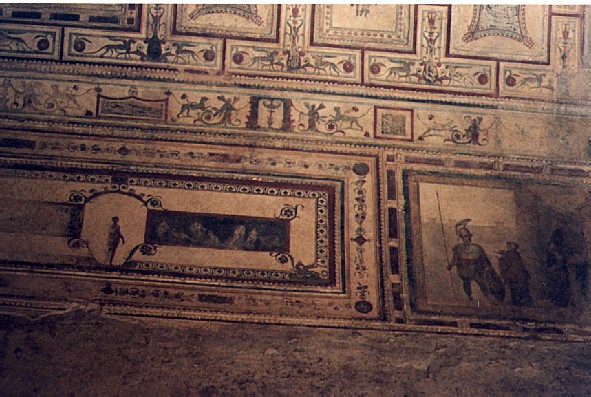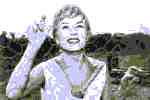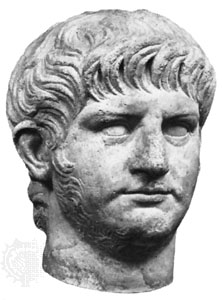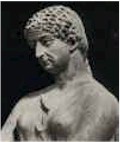|

APRIL MEETING
IL GATTOPARDO AND
THE ITALIAN UNIFICATION
|
The April presentation is traditionally given by someone affiliated
with Washington University, and, this year, we are especially honored because
our speaker will be Michael Sherberg, Associate Professor of Italian
and Director of WU’s program of Italian Language and Literature.
Dr. Sherberg will speak about Giuseppe Tomasi di Lampedusa’s great novel,
Il
Gattopardo, the powerful story based on Tomasi’s recollections of his
own grandfather, Don Fabrizio, Prince of Salina, and of the sweeping
changes in Sicilian society following the unification of Italy. Dr.
Sherberg states that although he normally spends his time in the 14th and
16th centuries, he has become a dedicated lover of Sicilian novels written
since the time of the Italian unification and particularly of the great
Il
Gattopardo.
The presentation should be especially interesting to those who attended
the Italian Club’s tremendously successful screening of the film Il Gattopardo
at the St. Louis Art Museum on January 19. Michael Sherberg has spoken
to our Club on several occasions and as always it will be a pleasure to
have him with us.
April is also the month when the Club presents its Frank LoPiccolo
and Mario Pertici Memorial Awards to outstanding WU students
of Italian language to assist in their attendance at the University’s Italian
Language Summer Program at Arezzo. WU Professor of Romance Languages,
John Garganigo, Director of the Arezzo program, will introduce the Award
recipients. It will be good to have him with us again as well.
|
|
Next Meeting April 18, 6:30 PM
Da Baldo's Restaurant
|

RECAP OF MARCH
MEETING
| DOMUS AUREA |
 Many thanks
to Dr. Anna Amelung, who gave a brilliant presentation on the Emperor
Nero and the Domus Aurea. Many thanks
to Dr. Anna Amelung, who gave a brilliant presentation on the Emperor
Nero and the Domus Aurea.
Nero (A.D. 37-68) is one of the most controversial political figures
of ancient Rome. Historians depict him as a monster and a murderer,
famous for his cruelty as well as his violent appetites. According
to ancient sources he was responsible for the deaths of his stepbrother
Britannicus, his first wife Octavia, his mother Agrippina, his second wife
Poppaea, and countless other Roman citizens.
Nero exhibited non-Roman characteristics throughout his life:
he had a deep disregard for traditional Roman customs and inherited from
his family pride, arrogance, exhibitionism and corruption; he loved to
scandalize the upper classes by putting himself above the law; he was extremely
egocentric and a megalomaniac; he loved all occupations which were considered
unsuitable for an emperor, such as painting, carving, singing, playing
the lyre and driving his chariot; he needed the approval of the crowd and
wanted to be the center of attention. A pacifist at heart, he disliked
war and refused to have his gladiators put to death.
Nero was also a passionate hellenophile and envisioned himself as a
Hellenistic ruler, an absolute eastern monarch with divine attributes.
As Suetonius and Tacitus point out, Nero was eager to perform the incredible,
and he had a longing for immortality and fame. Soon he identified
himself with the Sun God and thought he would bring a new Golden Age to
the world, an age of peace and of extraordinary architectural and engineering
feats. His love for the grandiose is easily seen in the projects
he undertook. He attempted to dig a canal across the Isthmus of Corinth,
another from Lake Avernus to Ostia, and another from Misenum to Lake Avernus.
These gigantic enterprises are revealing of his ambition and desire to
conquer nature, tame it, and submit it to his wishes.
As the Sun God, Nero felt that he needed a new residence that could
truly reflect his majesty and power. The great fire of Rome gave
him the opportunity to achieve his golden dream. In A.D. 64 a great
fire ravaged the city of Rome, badly damaging 10 of its l4 districts.
Nero confiscated 200 acres of land in downtown Rome and hired the architects
Severus and Celer to rebuild the area according to his new plans.
 The new complex,
known as the Domus Aurea (Golden House), was built on five hills
and included several buildings connected by monumental porticoed roads.
On the Palatine Hill, the Domus Tiberiana was rebuilt on a large
platform surrounded by colonnades and landscaped with hanging gardens.
On the Velian Hill, inside a monumental vestibule several stories high,
stood the colossal statue of the emperor, about 120 feet high and thus
taller than the Colossus of Rhodes. This bronze statue, the work
of Zenodorus, was later transferred to a spot near the Flavian amphitheater,
which was soon known as the Colosseum because of its proximity to the statue. The new complex,
known as the Domus Aurea (Golden House), was built on five hills
and included several buildings connected by monumental porticoed roads.
On the Palatine Hill, the Domus Tiberiana was rebuilt on a large
platform surrounded by colonnades and landscaped with hanging gardens.
On the Velian Hill, inside a monumental vestibule several stories high,
stood the colossal statue of the emperor, about 120 feet high and thus
taller than the Colossus of Rhodes. This bronze statue, the work
of Zenodorus, was later transferred to a spot near the Flavian amphitheater,
which was soon known as the Colosseum because of its proximity to the statue.
Where the Colosseum is now located was dug a large artificial lake,
the stagnum Neronis, surrounded by colonnades. Across from
it, on the Oppian Hill, a large pavilion was built, surrounded by gardens,
vineyards, meadows, sloped terraces, and orchards
that occupied the Esquiline Hill. On the Caelian Hill, a temple
was transformed into a monumental nymphaeum. This extraordinary architectural
complex was short lived. After Nero's death, most of the land was
returned to the Roman people by the emperor Vespasian who, like his successors,
attempted to obliterate Nero's achievements and discredit his memory.
In l04 the pavilion on the Oppian Hill (the present Domus Aurea)
was used as substructure to the Trajan Baths. Stripped of all its
valuable contents, it was filled with earth and rubble, reinforced with
sturdy walls, and used as the foundation for the new baths. The Domus
Aurea laid buried underground completely forgotten for many centuries
until, toward the end of the 15th century, an accidental cave-in opened
a passageway to the buried building. People began lowering themselves
in what seemed like a huge grotto with ancient paintings and soon a new
style emerged, called "grotesque" (from "grotto") which imitated the pictorial
motifs found in the Domus Aurea. Ghirlandaio, Filippino Lippi,
Pinturicchio, Raphael and Michelangelo himself were strongly influenced
by the magnificent vaulted ceilings and their fantastic decorations.
Today the Domus Aurea has been restored and is open to the public.
This magnificent building was decorated with the most expensive and
opulent material available at that time under the supervision of the painter
Fabullus: polichrome marble covered the walls of the main rooms;
mosaics, mother-of-pearl and seashells decorated the nymphaeum of Ulysses;
gold leaf covered the ceilings of some rooms. Built according to
the plan of a Roman seaside villa, it had large windows and doors and a
southern exposure to let in the light and allow the guests to enjoy the
breathtaking view of the landscaped terraces and the lake below.
The west wing centered around the myths of Bacchus and Hercules, myths
of rebirth and initiation much cherished by Nero as representing his new
Golden Age. The east wing depicts scenes of the Trojan War, symbolizing
the new Rome rebuilt by Nero after the great fire.
The Domus Aurea was not meant to be lived in: bathrooms,
kitchens and a heating system have not been found. It was built to
be a "dynamic" house, where guests could circulate from room to room as
in a museum, relax, meditate by a waterfall, and enjoy the many works of
art and the entertainment provided by their host Nero. It contained
large reception rooms, a peristyle, courtyards, and perhaps even fountains
and gardens on the roof. Suetonius tells us that some rooms were
fitted with ivory panels and a sprinkling system to drop flowers and perfumes
on the delighted guests. The main attraction was perhaps the octagonal
room, which may have had a hanging ceiling that revolved constantly.
In this room, flooded with light streaming from its large oculus (opening
in the ceiling), Nero probably displayed his most precious statues such
as the Dying Galatian and the Laocoon.
After being lost from memory for so many centuries, the Domus Aurea
now has a chance to live again. Although it lacks light, its main
element, this pavilion still astonishes visitors with its majesty, enormous
size, daring concrete vaults and architectural complexity. Nero's
golden dream still lives on. Grazie, Nerone!
|
|

L’ANGOLO DEL PRESIDENTE
By Gene Mariani |
WELCOME!
|
| We are pleased to announce that Raymond Farina was accepted
as a member of the Italian Club of St. Louis at the March 21, 2001 meeting.
Welcome, Raymond to our group. It is good to have you with us. |
ANNOUNCEMENTS
|
ITALIAN CLUB’S CONVERSATION
TABLE
|
| The Italian Club’s Italian conversation group will meet on Thursday
evening, April 12, at 7:00 p.m. at the Shaw Community School 5329 Columbia
Avenue. The Italian Table is intended for people who have studied
some Italian, have a basic knowledge of the language, and would like to
practice conversation in a small group setting with the help of an Italian-speaking
facilitator. If you are interested in participating or would like
more information, contact Gene Mariani at 352-5484 or by email at emariani@aol.com.
|
CONGRATULATIONS
|
Congratulations are in order for member Dr. Carla Bossola who
is one of the recipients of the 2001 Council of Students of Arts &
Sciences teaching awards. She will receive the award at a ceremony
on Tuesday, April 10, 2001, from 4:30 and 6:00 p.m. at Holmes Lounge.
Congratulazioni Carla!
|
THE ITALIAN HERITAGE AWARD
|
| Each June, the Club presents its Italian Heritage Award to an individual
who has distinguished him or herself through unselfish community service.
Members who would like to nominate someone for this award should submit
their nominations to Club Secretary Marie Cuccia-Brand either by
e-mail at mcucciasbj@aol.com or
by phone at 314-993-2252. Please include a brief explanation giving
the reasons why you think the person should receive the award.
|

BOB KRAMER’S MARIONETTES
|
On Sunday, June 26th, at 1:30 p.m., the Italian Club of St. Louis will
sponsor an afternoon of family entertainment. There will be a backstage
tour of the theatre plus a performance with marionettes singing opera arias.
Immediately following the performance, refreshments will be served on the
patio. Tickets purchased in advance through the Italian Club of St.
Louis are $5.50. We hope to see our members and their children
and grandchildren!
|
|

THE ART OF THE SAINTE-CHAPELLE
IN PARIS AND THE CRUSADE OF SAINT LOUIS
|
At the March meeting, Sal Sutera, who is also a member of the
Saint-Louis-Lyon Sister Cities, Inc., announced the First Annual Jacques
Chicoineau Lecture to be held on Friday, April 27, 2001, at 7 p.m., at
Steinberg Hall on the campus of Washington University, Gallery of Art.
This lecture, presented by Daniel H. Weiss, Ph.D., Professor of
Art History at Johns Hopkins University, will explore the art and
architecture of the extraordinary palace chapel built by Louis IX of France
to house the relics of the Passion. Through its architectural design
and lavish program of decoration, the Sainte-Chapelle reveals the fascination
of Saint Louis with the ideal of biblical kingship and his planned crusade
to the Holy Land.
|
|

MOSTRA: ITALIA, TERRA
DI SEDUZIONI
E DI GRANDI VIAGGIATORI
|
“Viaggio in Italia, un corteo magico dal Cinquecento al Novecento”,
è allestita in occasione del G8 che si terrà nella Superba
(Palazzo Ducale, fino al 29 luglio) a Genova. Questa mostra illustra
ciò che videro e lasciarono nell’Italia i turisti dei secoli passati
ed è un potente ricognizione di quanto il Bel Paese ha fornito in
materia di pittura, vedutismo, paesaggio e letteratura di viaggio nel corso
di cinque secoli. Così, accanto a imortantissime opere italiane
di Tiziano, Pontormo, Giorgione, Raffaello, Domenichino, Guido Reni, e
i Carracci, sono le lettere di Sade, di Winckelmann, di Byron, di Henry
James, di Proust, manoscritti autografi di Machiavelli, di Goethe, la “Gerusalemme
liberata” di Tasso, “A Silvia” di Leopardi, la partitura di “Così
fan tutte” di Mozart e altri.
“Voyage to Italy, a magical court from the 1500’s to the 1900’s”, was
organized in occasion of the G8 meeting, which will be shown at the Superba
(Palazzo Ducale, until July 29) in Genova. This exhibit illustrates
that which the tourists saw and left in Italy during past centuries. It
shows the importance which Italy, the “Bel Paese” furnished in the way
of scenery and pictures in the course of five centuries. Next to
important Italian works of art by Titian, Pontormo, Giorgione, Raffael,
Domenichino, Guido Reni, and the Carracci, are letters by Byron, Henry
James, Proust and an original manuscript of Machiavelli, Goethe, and “Jerusalem
Liberated” by Tasso, “A Silvia” by Leopardi, and the score of “Così
fan tutte” by Mozart, and others.
|
|

WHO ARE THE NEW ITALIANS?
|
As Italy's population ages, with an overall birth rate close
to zero and an increase in the average life span of both men and women,
the need for a constantly renewed labor force is becoming critical. That
is what the Federation of Industrialists, a group of major employers, is
saying when it calls for a rise in immigration quotas. According to the
Federation, the quota should be increased to 105,000 annually. Instead
the government is proposing a total of 63,000 for 2001. At least 13,000
seasonal workers are expected to be allowed to immigrate temporarily to
fill jobs in the agriculture and the hospitality trade. The largest
group of immigrants in Italy comes from Morocco, they number 150,000.
Albanians are in second place, with 130,000. Filipinos and immigrants from
Ecuador number 62,000 each, with Romanians close behind at 60,000. There
are 50,000 Chinese immigrants in Italy; they run 500 enterprises in Rome
alone.
Americans in Italy number 45,000 and Tunisians 42,000. (From
Italy Italy Magazine) |
|

ITALIAN CLUB FILM SERIES
|
This spring we are continuing the Italian Club of
St. Louis’s; popular Films at the Bocce Club series of classic Italian
films. The films will be in Italian with English subtitles with an
introduction by Dr. Carla Bossola, lecturer sponsored by the Italian Ministry
of Foreign Affairs. The films will be shown at 7 p.m. at the Italia-America
Bocce Club, 2210 Marconi Avenue, on Friday nights April 6 and May 4.
There is no admission charge.
 Le notte di Cabiria (The Nights of Cabiria) will be shown on April 6. Fellini's
classic drama about a childlike prostitute who remains curiously unsullied
by the brutal world she inhabits, even as the love and respectability she
seeks elude her. The film, showcases Fellini's favorite actress,
his wife Giulietta Masina--and inspired the Broadway and Hollywood hit
Sweet Charity.
Le notte di Cabiria (The Nights of Cabiria) will be shown on April 6. Fellini's
classic drama about a childlike prostitute who remains curiously unsullied
by the brutal world she inhabits, even as the love and respectability she
seeks elude her. The film, showcases Fellini's favorite actress,
his wife Giulietta Masina--and inspired the Broadway and Hollywood hit
Sweet Charity.
 La Ciociara (Two Women) will be shown on May 4. Directed by Vittorio
De Sica, and based on Alberto Moravia’s book by the same name, this movie
stars Sophia Loren and depicts the ravages of World War II on a mother
and daughter as they try to escape Rome. Sophia Loren won best actress
awards at the Academy Awards and Cannes Film Festival for her performance
in this film.
La Ciociara (Two Women) will be shown on May 4. Directed by Vittorio
De Sica, and based on Alberto Moravia’s book by the same name, this movie
stars Sophia Loren and depicts the ravages of World War II on a mother
and daughter as they try to escape Rome. Sophia Loren won best actress
awards at the Academy Awards and Cannes Film Festival for her performance
in this film.
For further information, please call Gene Mariani at 314-352-5484 |
|

FILM PREMIERE
|
The Washington University premiere of the film Left Luggage will
take place on Saturday, April 21 at 8 p.m. at Brown Hall (near Forsyth
and Chaplin Drive).
This film stars Isabella Rossellini and was directed by Jeroen
Krabbe (The Fugitive). It is set in Antwerp, Belgium and relates
the story of Chaja, an impetuous, liberal-minded philosophy student, and
her complex relationship with her parents who are Holocaust survivors.
A performance by the vocal group The Pikers will precede the screening
and a panel discussion with Washington University faculty will follow.
There is no admission charge. |
|

EASTER RECIPE
|
Congratulations to our members Maria Grazia Hayes and Josephine
Barrale for appearing on the March 19, 2001, edition of "Show
Me St. Louis" television program on channel KSDK. Maria Grazia prepared
some traditional Sicilian dishes, including the following:
Con Gusto's Italian Easter Recipes Pupa Co L'ova
Ingredients:
2 1/2 cups flour
1/3 cup sugar
1/4 teaspoon baking powder
1/2 cup and 2 tablespoons of butter
1/2 cup of warm milk
1 beaten egg
1 teaspoon almond extract
2 tablespoons finely chopped almonds, almost paste
form
Directions: Combine flour, sugar, baking powder,
cut in butter and mix well. Stir in milk and egg until dry
mixture is moistened. Add the almond extract and the finely chopped almonds.
Roll dough in lightly floured surface to 1/2 inch rectangle.
Draw and cut a form of a doll. In the bottom shape
(skirt), set 2 boiled eggs, colored if desired, and bake at 350 degrees
for 20 to 25 minutes. Sprinkle granulated sugar on top
before serving.
|
|


|
I capolavori della poesia
italiana
30. Alessandro Manzoni. (Milano 1785 –1873) visse
durante un periodo di grandi cambiamenti nella scena politica italiana,
come è evidente nelle sue opere che spesso si svolgono intorno alla
storia, a volte studiata sotto l’aspetto morale nei suoi saggi e soprattutto
interpretata poeticamante nelle sue poesie, nelle sue tragedie e nel suo
capolavoro, il romanzo I promessi sposi. Il Manzoni compose l’ode
Il cinque maggio pochi giorni dopo aver ricevuto la notizia della morte
di Napoleone Bonaparte (5 maggio 1821). L’ode consiste di 108 versi
che celebrano la grandezza dell’uomo che cambiò il corso della storia
europea, soffermandosi nella parte finale sulla solitudine della sua morte
a Sant’Elena.
Il cinque maggio
di Alessandro Manzoni
Ei fu. Siccome immobile,
dato il mortal sospiro,
stette la spoglia immemore
orba di tanto spiro,
così percossa, attonita
la terra al nunzio sta,
muta pensando all’ultima
ora dell’uom fatale;
né sa quando una simile
orma di piè mortale
la sua cruenta polvere
a calpestar verrà.
Lui folgorante in solio
vide il mio genio e tacque;
quando, con voce assidua,
cadde, risorse e giacque,
di mille voci al sònito
mista la sua non ha:
vergin di servo encomio
e di codardo oltraggio,
sorge or commosso al sùbito
sparir di tanto raggio;
e scioglie all’urna un cantico
che forse non morrà.
vv 1-24
|
|
|
|
|

LA STORIA D’ITALIA
| (Continua dal numero precedente)
21. Nerone (37–68 d.C. - Imperatore 54–68 d.C.)
 Nel 54 Nerone non
aveva ancora 17 anni ed era perciò la prima volta che il potere
assoluto dell’impero romano si trovava nelle mani di un adolescente.
La madre Agrippina immediatamente si diede da fare per eliminare
il liberio Narciso, che precedentemente aveva ostacolato i suoi piani,
e cercò in tutti i modi di prendere in mano il potere, ma Sesto
Afranio Burro, prefetto del pretorio, e il filosofo stoico Seneca,
precettore di Nerone, benché entrambi dovessero la loro posizione
ad Agrippina, incoraggiarono Nerone ad agire indipendentemente da lei. Nel 54 Nerone non
aveva ancora 17 anni ed era perciò la prima volta che il potere
assoluto dell’impero romano si trovava nelle mani di un adolescente.
La madre Agrippina immediatamente si diede da fare per eliminare
il liberio Narciso, che precedentemente aveva ostacolato i suoi piani,
e cercò in tutti i modi di prendere in mano il potere, ma Sesto
Afranio Burro, prefetto del pretorio, e il filosofo stoico Seneca,
precettore di Nerone, benché entrambi dovessero la loro posizione
ad Agrippina, incoraggiarono Nerone ad agire indipendentemente da lei.
 Nel 56
Agrippina è messa in disparte e Burro e Seneca restano al potere.
Fino al 59 soltanto atti di generosità e di clemenza sono attribuiti
a Nerone: proibisce gli spettacoli crudeli dei gladiatori nel
circo, abolisce la pena di morte, riduce le tasse ai meno abbienti, dà
il diritto agli schiavi di accusare i padroni ingiusti. Inoltre inaugura
competizioni poetiche, teatrali e sportive per sostituire gli spettacoli
che aveva abolito e soddisfare il popolo assetato di divertimenti.
Dà assistenza alle città che erano state vittime di disastri
e aiuto agli ebrei. Nel 56
Agrippina è messa in disparte e Burro e Seneca restano al potere.
Fino al 59 soltanto atti di generosità e di clemenza sono attribuiti
a Nerone: proibisce gli spettacoli crudeli dei gladiatori nel
circo, abolisce la pena di morte, riduce le tasse ai meno abbienti, dà
il diritto agli schiavi di accusare i padroni ingiusti. Inoltre inaugura
competizioni poetiche, teatrali e sportive per sostituire gli spettacoli
che aveva abolito e soddisfare il popolo assetato di divertimenti.
Dà assistenza alle città che erano state vittime di disastri
e aiuto agli ebrei.
Secondo alcuni storici, con l’abolizione del tasso doganale Nerone inimicò
la classe privilegiata che sotto gli imperatori precedenti si era arricchita
con i soprusi, quella stessa categoria che aveva appoggiato la sua investitura.
Di conseguenza gli aristocratici cominciarono a contrastarlo e a seminare
discredito su di lui come un individuo dissoluto, irresponsabile e libidinoso.
Nel 59 Nerone sospetta che sua madre stia tramando qualche congiura.
La invita a Baia nel mese di marzo per celebrare la grande festa del Quinquatrie
e, terminati i festeggiamenti, fa in modo che l'imbarcazione che doveva
ricondurla ad Anzio naufragasse. Agrippina si salva a nuoto e raggiunge
una delle sue ville a Lucrino dove viene uccisa. Viene messa in giro
la voce che la madre voleva uccidere il figlio e che, fallito il piano,
si fosse suicidata sicché il giorno dopo, venne celebrato con entusiasmo
lo scampato pericolo di Nerone.
A 20 anni Nerone incontra Poppea Sabina, donna famosa per la
sua bellezza e moglie del senatore Salvio Otone, futuro imperatore, e vuole
sposarla, ma naturalmente il matrimonio è ostacolato dalla presenza
di Ottavia, la moglie che Agrippina aveva scelto per lui.
Nel 62 Nerone accusa Ottavia di adulterio, la fa uccidere e dopo 12 giorni
sposa Poppea.
Durante questo periodo a Roma il lusso aveva raggiunto il culmine.
Nerone, a cui Seneca aveva insegnato ad apprezzare le raffinatezze, amava
l’eleganza, l'arte, la musica, la poesia, la danza, le collezioni di oggetti
d'arte e i piaceri dell'alta cucina. Suo fedele amico era Gaio
Petronio Arbitrio, uno dei più raffinati personaggi di Roma
e arbitro del buon gusto. Ma Nerone andò oltre. Convinto
di essere un grande poeta, attore e musicista, cominciò ad esibirsi
in pubblico nei teatri. Per i Romani questo era esibizionismo di
cattivo gusto perciò è probabile che i preliminari di quella
che sarà la congiura di Pisone, un esponente dell'antica nobiltà
romana, abbiano inizio durante questo periodo.
Nel 64, quando un incendio devastò la città, Nerone ne
approfitta per costruire la Domus Aurea, la cui area, una volta
finita, sarebbe stata quella di un terzo della città. Nerone
si trovava nella sua villa di Anzio quando scoppiò l’incendio, perciò
non poteva essere stato lui ad iniziarlo, ma il popolo pensò che
l’avesse fatto lui con lo scopo di costruire la Domus Aurea nella
zona bruciata. Secondo gli Annales di Tacito e il Nerone
di Suetonio, Nerone accusò i cristiani e gli ebrei del reato
per allontanare da sè i sospetti. A quel tempo i Romani non
facevano distinzione tra ebrei e cristiani, ma Poppea, che fin da giovane
era stata molto vicina alla religione ebraica, intercedette a favore degli
ebrei lasciando che i cristiani venissero scelti come capro espiatorio.
E’ così che Nerone acquistò la dubbia fama di essere stato
il primo persecutore dei cristiani.
Nel frattempo erano scoppiate rivolte in varie parti dell’impero:
in Oriente era ripresa la guerra col regno dei Parti per il possesso dell'Armenia;
una ribellione era scoppiata in Britannia; nel 66 si ribellarono gli Ebrei
di Palestina; agitazioni si ebbero anche in Gallia, sul Reno, e nella Mesia.
A Roma Gaio Calpurnio Pisone organizzò un complotto per deporre
l’imperatore. Ma Nerone venne a saperlo e il tentativo finì
con 19 giustiziati e 13 esiliati. Tra le vittime Seneca, il poeta
Lucano (entrambi costretti a suicidarsi) Pisone e Petronio.
Morta Poppea, forse anche lei uccisa dal marito, Nerone sposa Messalina
Statilia e nel 66 va in Grecia, dove annuncia il dono della libertà
ai Greci e il taglio dell’Istmo di Corinto, raggiungendo il massimo della
sua gloria. Il progetto desta grande impressione in Grecia e in tutto
l'Impero. Al suo ritorno a Roma, è salutato come Ercole e
Apollo e gli vengono attribuiti onori divini.
Ma altre ribellioni si scatenano nell’impero capeggiate da Sulpicio
Galba nella penisola Iberica e da Giulio Vindice in Gallia.
I due si alleano, ottengono l’appoggio del Senato, e dichiarano Galba imperatore.
Nerone è costretto a fuggire e, rimasto solo con il suo liberto
Epafrodito, si rifugia nella villa di Faone, dove, prima che i soldati
possano raggiungerlo, si trafigge la gola con una spada. Era il 9
giugno 68 e Nerone aveva esattamente 30 anni e sei mesi. Finisce
con lui la dinastia giulio-claudia. Molti in seguito lo compiansero
e la sua tomba fu a lungo coperta di fiori. In Grecia fu ricordato
per molti anni con grande cerimonie come un essere soprannaturale che un
giorno sarebbe ritornato per essere di nuovo imperatore.
(continua al prossimo numero)
|

|
|